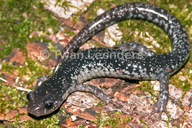|
Plethodon variolatus (Gilliams, 1818)
South Carolina Slimy Salamander Subgenus: Plethodon | family: Plethodontidae subfamily: Plethodontinae genus: Plethodon |
| Species Description: Gilliams, J. 1818. Description of two new species of Linnaean Lacerta. Journal of the Academy of Natural Sciences of Philadelphia 1: 460. | |
 © 2007 Twan Leenders (1 of 14) |
|
|
|
Description Plethodon variolatus has distinguishable white and brass-colored fleckings along their sides and dorsal surface. Similar species -- like P. chattahoochee and P. chlorobryonis-- lack this distinctive feature (Highton et al. 1989). In life, the dorsal surface is black and the ventral surface is lighter. The chin is significantly lighter than other parts of the body. There are small white spots that speckle the dorsal edges, and they each have brassy flecking near their edges. There are many distinct yellow spots on the sides of the body, and there are some scattered yellow specks on the chin and ventral surface (Highton et al. 1989). Distribution and Habitat Country distribution from AmphibiaWeb's database: United States U.S. state distribution from AmphibiaWeb's database: Georgia, South Carolina
Life History, Abundance, Activity, and Special Behaviors Eggs are laid on land. Common egg-laying locations include rotting tree stumps, underground, or in rock crevices. Plethodon variolatus adults are terrestrial and rarely spotted in nature (Petranka 1998). All members of Plethodon secrete noxious substances that can harm predators; additionally, many members of the Plethodon genus will assume defensive positions or become immobile as anti-predator mechanisms (Brodie 1977). Trends and Threats Possible reasons for amphibian decline General habitat alteration and loss Comments Plethodon variolatus is a member of the P. glutinosus complex. This species complex was originally identified almost exclusively by non-genetic biochemical (allozyme and immunological albumins) characteristics. Other species in the P. glutinosus complex include P. teyahalee, P. chattahoochee, P. chlorobryonis, P. ocmulgee, P. kiamichi, P. mississippi, P. kisatchie, P. sequoyah, P. grobmani, P. cylindraceus, P. albagula, P. savannah, P. aureolus, and P. kentucki (Highton et al. 1989). Bayesian and Maximum Parsimony analyses of the mitochondrial DNA region from ND2 to tRNAAla and a re-analysis of allozyme data (originally collected by Highton and Peabody in 2000) by Weisrock et al. (2005) found P. cholorobryonis and P. variolatus formed a clade that had a large genetic distance from the other members of the P. glutinous complex. While this wasn't supported by their parsimony analysis, further analysis by Smith et al. (2018) supported the Bayesian results, leading researchers to hypothesize that the P. chlorobyronis - P. variolatus clade diverged from the P. glutinosus complex earlier than other species. Still, a more in-depth genetic analysis of the P. glutinosus complex is required to fully understand these complexities (Smith et al. 2018). Plethodon variolatus' common name, South Carolina Slimy Salamander, was chosen because this species is found primarily in South Carolina and is a member of the slimy salamander complex (Highton et al. 1989). The P. variolatus holotype has been lost. Instead, an adult male specimen collected by David E. Carr in 1986 was designated as the neotype by Highton et al. in 1989.
References
Brodie, E. D., Jr. (1977). "Salamander antipredator postures." Copeia, 1977, 523-535. Carr, David E. (1996). ''Morphological Veriation among species and populations of salamanders in the Plethodon glutinosus complex.'' Herpetologica, 52(1), 56-65. [link] Highton, Richard., Maha, G.C., and Maxson, L.R. (1989). ''Biochemical evolution in the Slimy Salamanders of the Plethodon glutinosus Complex in the eastern United States.'' Illinois Biological Monographs, 57. Petranka, J. W. (1998). Salamanders of the United States and Canada. Smithsonian Institution Press, Washington D.C. and London. Schurbon, Jamie M., and John E. Fauth (2003). ''Effects of prescribed burning on amphibian diversity in a Southeastern U.S. National Forest.'' Conservation Biology, 17(5). [link] Smith, Walter H., Wooten, J.A., Camp, C.D., Stevenson, D.J., Jensen, J.B., Turner, M., and Alexander, N.R. (2018). ''Genetic divergence correlates with the contemporary landscape in populations of Slimy Salamander (Plethodon glutinosus) species complex across the lower piedmont and coastal plain of the Southeastern United States.'' Canadian Journal of Zoology, 96(11), 1244-1254. Weisrock, D. W., Kozak, K. H., and Larson, A. (2005). ''Phylogeographic analysis of mitochondrial gene flow and introgression in the salamander, Plethodon shermani.'' Molecular Ecology, 14, 1457-1472. Originally submitted by: Ash Reining (first posted 2021-01-26) Edited by: Ann T. Chang (2021-02-01) Species Account Citation: AmphibiaWeb 2021 Plethodon variolatus: South Carolina Slimy Salamander <https://amphibiaweb.org/species/4157> University of California, Berkeley, CA, USA. Accessed May 14, 2025.
Feedback or comments about this page.
Citation: AmphibiaWeb. 2025. <https://amphibiaweb.org> University of California, Berkeley, CA, USA. Accessed 14 May 2025. AmphibiaWeb's policy on data use. |


 Raffaëlli Account
Raffaëlli Account Map of Life
Map of Life